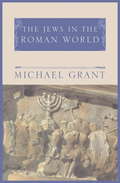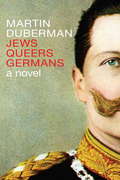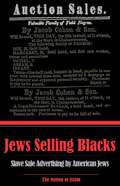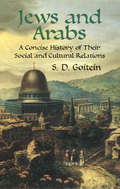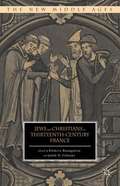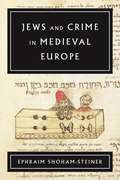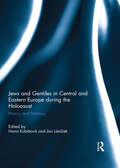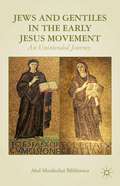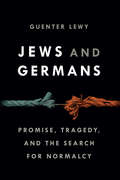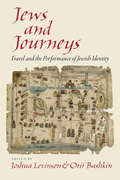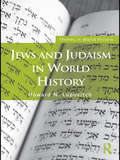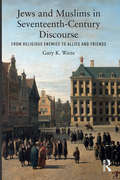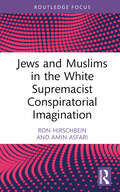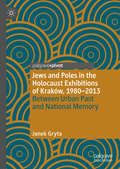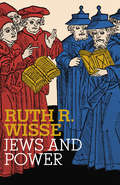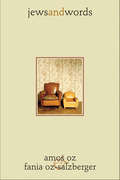- Table View
- List View
Jews In The Roman World
by Michael GrantIn describing the triangular relationship among the Jews, the Romans and the Greeks, Michael Grant treats one of the most significant themes in world history.Unlike almost all the other subject nations of the Roman empire, the Jews have survived and have maintained a religious and cultural identity that is substantially unchanged. They provide a unique bridge with the ancient world and can bring us into peculiarly close and intimate contact with life in the Roman empire.This book embraces the period in which the Jewish religion assumed virtually its final form, and in which Jews launched their two heroic, but disastrous revolts against Roman rule. This was, moreover, the time when Judaism gave birth to Christianity. Within a century after the death of Jesus, his followers had become completely independent of Judaism. Michael Grant describes the grandeur of the great multiracial Roman empire, beneath whose rule these stirring and unique developments took place.
Jews In The Roman World
by Michael GrantIn describing the triangular relationship among the Jews, the Romans and the Greeks, Michael Grant treats one of the most significant themes in world history.Unlike almost all the other subject nations of the Roman empire, the Jews have survived and have maintained a religious and cultural identity that is substantially unchanged. They provide a unique bridge with the ancient world and can bring us into peculiarly close and intimate contact with life in the Roman empire.This book embraces the period in which the Jewish religion assumed virtually its final form, and in which Jews launched their two heroic, but disastrous revolts against Roman rule. This was, moreover, the time when Judaism gave birth to Christianity. Within a century after the death of Jesus, his followers had become completely independent of Judaism. Michael Grant describes the grandeur of the great multiracial Roman empire, beneath whose rule these stirring and unique developments took place.
Jews Queers Germans: A Novel
by Martin DubermanA breathtaking historical novel that recreates the intimate milieu around Germany's Kaiser Wilhelm from 1907 through the 1930s, a period of great human suffering and destruction and also of enormous freedom and creativity, a time when the remnants and artifices of the old word still mattered, and yet when art and the social sciences were pirouetting with successive revolutions in thought and style. Set in a time when many men in the upper classes in Europe were gay, but could not be so publicly, Jews Queers Germans revolves around three men: Prince Philipp von Eulenburg, Kaiser Wilhelm II's closest friend, who becomes the subject of a notorious 1907 trial for homosexuality; Magnus Hirschfeld, a famed, Jewish sexologist who gives testimony at the trial; and Count Harry Kessler, a leading proponent of modernism, and the keeper of a famous set of diaries which lay out in intimate detail the major social, artistic and political events of the day and allude as well to his own homosexuality. The central theme here is the gay life of a very upper crust intellectual milieu that had a real impact on the major political upheavals that would shape the modern world forever after.From the Trade Paperback edition.
Jews Selling Blacks: Slave Sale Advertising by American Jews
by Nation Of IslamThere are 140 pages of ads reproduced from American newspapers of the slavery era. There are Jews selling Blacks as individuals, in gangs, and as families. Jewish community leaders--and even rabbis--offer to buy and sell Black human beings without any moral compunction. When Blacks tried to escape, Jewish slave owners used the newspapers to track them down. Jews acting as slave auctioneers, slave shippers, and insurers of enslaved Blacks also placed ads. Jews bought and sold whole plantations--slaves and all--and they marketed slaves who ranged in age from infants to the elderly. In addition, Jewish merchants arranged bank financing for the purchasers of Black men, women, and children--Black slaves on layaway.
Jews and Arabs: A Concise History of Their Social and Cultural Relations
by S. D. GoiteinThis fascinating history by an eminent scholar explores the relationship between Jews and Arabs, from their beginnings 3,000 years ago into the 1970s. Although originally written in 1954, it was revised in 1974 to extend its reach in the aftermath of the 1973 Yom Kippur War. The account remains current in its outlook because of the focus on social and cultural contacts as opposed to political and military issues. Its long-range examination of the reciprocal influence between these two peoples provides many valuable insights into the present-day impasse in their relations.Jews and Arabs encompasses numerous subjects of historical and contemporary relevance: the myth of the so-called Semitic races; the Jewish tradition in Islam; the actual and legal position of Jews under Arabic Islam; the rise of Jewish philosophy under Islamic influence; Jewish and Islamic mysticism and poetry; and law and ritual. Author S. D. Goitein was the first professor of Islamic studies at Jerusalem's Hebrew University, and this study reflects his 30 years of experience in the field, which includes surveys of Muslim religious literature, Oriental Jewish communities, and medieval Egyptian documents. Erudite and well written, this volume is indispensable to anyone seeking a deeper understanding of the complexities of the Arab-Jewish relationship.
Jews and Booze: Becoming American in the Age of Prohibition (Goldstein-Goren American Jewish History #2)
by Marni DavisFinalist, 2014 Sami Rohr Prize for Jewish Literature from the Jewish Book CouncilTraces American Jews’ complicated relationship to alcohol through the years leading up to and after prohibitionFrom kosher wine to their ties to the liquor trade in Europe, Jews have a longstanding historical relationship with alcohol. But once prohibition hit America, American Jews were forced to choose between abandoning their historical connection to alcohol and remaining outside the American mainstream.In Jews and Booze, Marni Davis examines American Jews’ long and complicated relationship to alcohol during the late nineteenth and early twentieth centuries, the years of the national prohibition movement’s rise and fall. Bringing to bear an extensive range of archival materials, Davis offers a novel perspective on a previously unstudied area of American Jewish economic activity—the making and selling of liquor, wine, and beer—and reveals that alcohol commerce played a crucial role in Jewish immigrant acculturation and the growth of Jewish communities in the United States. But prohibition’s triumph cast a pall on American Jews’ history in the alcohol trade, forcing them to revise, clarify, and defend their communal and civic identities, both to their fellow Americans and to themselves.
Jews and Christians in Thirteenth-Century France
by Elisheva Baumgarten Judah D. GalinskyIn light of the growing tendency to view both religious communities as intimately linked, this work seeks to examine a variety of perspectives on Jewish and Christian life in northern France during the thirteenth-century. Contributors investigate the social and cultural changes which took place in European medieval society through legal developments, religious polemic, gender, social history, perceptions of the 'other,' language, literature and art. A secondary, but no less important goal,of this collection is to break down the artificial boundaries that divide the various academic disciplines and those that separate 'medieval studies' from 'Jewish studies'.
Jews and Converts in Late Medieval Castile: Breaking with the Past (Studies in Medieval History and Culture)
by Cecil ReidJews and Converts in Late Medieval Castile examines the ways in which Jewish-Christian relations evolved in Castile, taking account of social, cultural, and religious factors that affected the two communities throughout the fourteenth and early fifteenth centuries. The territorial expansion of the Christian kingdoms in Iberia that followed the reconquests of the mid-thirteenth century presented new military and economic challenges. At the same time the fragile balance between Muslims, Jews, and Christians in the Peninsula was also profoundly affected. Economic and financial pressures were of over-riding importance. Most significant were the large tax revenues that the Iberian Jewish community provided to royal coffers, new evidence for which is provided here. Some in the Jewish community also achieved prominence at court, achieving dizzying success that often ended in dismal failure or death. A particular feature of this study is its reliance upon both Castilian and Hebrew sources of the period to show how mutual perceptions evolved through the long fourteenth century. The study encompasses the remarkable and widespread phenomenon of Jewish conversion, elaborates on its causes, and describes the profound social changes that would culminate in the anti-converso riots of the mid-fifteenth century. This book is valuable reading for academics and students of medieval and of Jewish history. As a study of a unique crucible of social change it also has a wider relevance to multi-cultural societies of any age, including our own.
Jews and Crime in Medieval Europe
by Ephraim Shoham-SteinerJews and Crime in Medieval Europe is a topic laced by prejudice on one hand and apologetics on the other. Beginning in the Middle Ages, Jews were often portrayed as criminals driven by greed. While these accusations were, for the most part, unfounded, in other cases criminal accusations against Jews were not altogether baseless. Drawing on a variety of legal, liturgical, literary, and archival sources, Ephraim Shoham-Steiner examines the reasons for the involvement in crime, the social profile of Jews who performed crimes, and the ways and mechanisms employed by the legal and communal body to deal with Jewish criminals and with crimes committed by Jews. A society’s attitude toward individuals identified as criminals—by others or themselves—can serve as a window into that society’s mores and provide insight into how transgressors understood themselves and society’s attitudes toward them. The book is divided into three main sections. In the first section, Shoham-Steiner examines theft and crimes of a financial nature. In the second section, he discusses physical violence and murder, most importantly among Jews but also incidents when Jews attacked others and cases in which Jews asked non-Jews to commit violence against fellow Jews. In the third section, Shoham-Steiner approaches the role of women in crime and explores the gender differences, surveying the nature of the crimes involving women both as perpetrators and as victims, as well as the reaction to their involvement in criminal activities among medieval European Jews. While the study of crime and social attitudes toward criminals is firmly established in the social sciences, the history of crime and of social attitudes toward crime and criminals is relatively new, especially in the field of medieval studies and all the more so in medieval Jewish studies. Jews and Crime in Medieval Europe blazes a new path for unearthing daily life history from extremely recalcitrant sources. The intended readership goes beyond scholars and students of medieval Jewish studies, medieval European history, and crime in pre-modern society.
Jews and Gentiles in Central and Eastern Europe during the Holocaust: History and memory
by Hana Kubátová and Jan LáníčekProviding diverse insights into Jewish–Gentile relations in East Central Europe from the outbreak of the Second World War until the reestablishment of civic societies after the fall of Communism in the late 1980s, this volume brings together scholars from various disciplines – including history, sociology, political science, cultural studies, film studies and anthropology – to investigate the complexity of these relations, and their transformation, from perspectives beyond the traditional approach that deals purely with politics. This collection thus looks for interactions between the public and private, and what is more, it does so from a still rather rare comparative perspective, both chronological and geographic. It is this interdisciplinary and comparative perspective that enables us to scrutinize the interaction between the individual majority societies and the Jewish minorities in a longer time frame, and hence we are able to revisit complex and manifold encounters between Jews and Gentiles, including but not limited to propaganda, robbery, violence but also help and rescue. In doing so, this collection challenges the representation of these encounters in post-war literature, films, and the historical consciousness. This book was originally published as a special issue of Holocaust Studies.
Jews and Gentiles in the Early Jesus Movement
by Abel Mordechai BibliowiczThis volume offers new insights on Jewish-Gentile relations and the evolution of belief in the early Jesus movement, suggesting that the New Testament reflects the early stages of a Gentile challenge to the authority and legitimacy of the descendants of Jesus' disciples and first followers as the exclusive guardians and interpreters of his legacy.
Jews and Germans: Promise, Tragedy, and the Search for Normalcy
by Guenter LewyJews and Germans is the only book in English to delve fully into the history and challenges of the German-Jewish relationship, from before the Holocaust to the present day. The Weimar Republic era—the fifteen years between Germany&’s defeat in World War I (1918) and Hitler&’s accession (1933)—has been characterized as a time of unparalleled German-Jewish concord and collaboration. Even though Jews constituted less than 1 percent of the German population, they occupied a significant place in German literature, music, theater, journalism, science, and many other fields. Was that German-Jewish relationship truly reciprocal? How has it evolved since the Holocaust, and what can it become? Beginning with the German Jews&’ struggle for emancipation, Guenter Lewy describes Jewish life during the heyday of the Weimar Republic, particularly the Jewish writers, left-wing intellectuals, combat veterans, and adult and youth organizations. With this history as a backdrop he examines the deeply disparate responses among Jews when the Nazis assumed power. Lewy then elucidates Jewish life in postwar West Germany; in East Germany, where Jewish communists searched for a second German-Jewish symbiosis based on Marxist principles; and finally in the united Germany—illuminating the complexities of fraught relationships over time.
Jews and India: Perceptions and Image (Routledge Jewish Studies Series)
by Yulia EgorovaExploring the image of Jews in India in the nineteenth and twentieth centuries, this book looks at both the Indian attitudes towards the Jewish communities of the subcontinent and at the way Jews and Judaism in general have been represented in Indian discourse. Despite the fact that the Indian Jewish population constitutes one of the country’s tiniest minorities, the relations of the local Jews with other communities form an integral part in the history of Indian multiculturalism. This has become increasingly apparent over the last two centuries as Judaism and its image have been incorporated into the discussions of some of the most prominent figures of different religious and nationalist movements, leaders of independent India, and the Indian mass media. Furthermore, recent decades witnessed mass adoption of Israelite identity by Indians from two different regions and religious groups. Being a topic that has received little attention, Jews and India seeks to rectify this situation by examining these developments and providing a fascinating insight into these issues. This volume will be of interest to scholars of Jewish and Indian cultural studies.
Jews and Intermarriage in Nazi Austria
by Evan Burr BukeyEvan Burr Bukey explores the experience of intermarried couples - marriages with Jewish and non-Jewish partners - and their children in Vienna after Germany's seizure of Austria in 1938. These families coped with changing regulations that disrupted family life, pitted relatives against each other, and raised profound questions about religious, ethnic, and national identity. Bukey finds that although intermarried couples lived in a state of fear and anxiety, many managed to mitigate, delay, or even escape Nazi sanctions. Drawing on extensive archival research, his study reveals how hundreds of them pursued ingenious strategies to preserve their assets, to improve their "racial" status, and above all to safeguard the position of their children. It also analyzes cases of intermarried partners who chose divorce as well as persons involved in illicit liaisons with non-Jews. Jews and Intermarriage in Nazi Austria concludes that although most of Vienna's intermarried Jews survived the Holocaust, several hundred Jewish partners were deported to their deaths and children of such couples were frequently subjected to Gestapo harassment.
Jews and Jewish Life in Russia and the Soviet Union
by Yaacov Ro'IThe main focus of this book is Jewish life under the Soviet regime. The themes of the book include: the attitude of the government to Jews, the fate of the Jewish religion and life in Post-World War II Russia. The volume also contains an assessment of the prospects for future emigration.
Jews and Journeys: Travel and the Performance of Jewish Identity (Jewish Culture and Contexts)
by Joshua Levinson and Orit BashkinJourneys of dislocation and return, of discovery and conquest hold a prominent place in the imagination of many cultures. Wherever an individual or community may be located, it would seem, there is always the dream of being elsewhere. This has been especially true throughout the ages for Jews, for whom the promises and perils of travel have influenced both their own sense of self and their identity in the eyes of others.How does travel writing, as a genre, produce representations of the world of others, against which one's own self can be invented or explored? And what happens when Jewish authors in particular—whether by force or of their own free will, whether in reality or in the imagination—travel from one place to another? How has travel figured in the formation of Jewish identity, and what cultural and ideological work is performed by texts that document or figure specifically Jewish travel? Featuring essays on topics that range from Abraham as a traveler in biblical narrative to the guest book entries at contemporary Israeli museum and memorial sites; from the marvels medieval travelers claim to have encountered to eighteenth-century Jewish critiques of Orientalism; from the Wandering Jew of legend to one mid-twentieth-century Yiddish writer's accounts of his travels through Peru, Jews and Journeys explores what it is about travel writing that enables it to become one of the central mechanisms for exploring the realities and fictions of individual and collective identity.
Jews and Judaism in Modern China (Routledge Jewish Studies Series)
by M. Avrum EhrlichJews and Judaism in Modern China explores and compares the dynamics at work in two of the oldest, intact and starkly contrasting civilizations on earth; Jewish and Chinese. The book studies how they interact in modernity and how each civilization views the other, and analyses areas of cooperation between scholars, activists and politicians. Through evaluation of the respective talents, qualities and social assets that are fused and borrowed in the civilizational exchange, we gain an insight into the social processes underpinning two contrasting and long surviving civilizations. Identifying and analysing some of the emerging current issues, this book suggests Jewish-Chinese relations may become a growing discipline of import to the study of religion and comparative identity, and looks at how the significant contrasts in Jewish and Chinese national constructs may serve them well in the quest for a meaningful discourse. Chapters explore identity, integrity of the family unit; minority status; religious freedom; ethics and morality; tradition versus modernity; the environment, and other areas which are undergoing profound transformation. Identifying the intellectual and practical nexus and bifurcation between the two cultures, worldviews and identities, this work is indispensable for students of Chinese studies, sociology, religion and the Jewish diaspora, and provides useful reading for Western tourists to China.
Jews and Judaism in World History (Themes in World History)
by Howard N. LupovitchThis book is a survey of the history of the Jewish people from biblical antiquity to the present, spanning nearly 2,500 years and traversing five continents. Opening with a broad introduction which addresses key questions of terminology and definition, the book’s ten chapters then go on to explore Jewish history in both its religious and non-religious dimensions. The book explores the social, political and cultural aspects of Jewish history, and examines the changes and continuities across the whole of the Jewish world throughout its long and varied history. Topics covered include: the emergence of Judaism as a religion and way of life the development during the Middle Ages of Judaism as an all-encompassing identity the effect on Jewish life and identity of major changes in Europe and the Islamic world from the mid sixteenth through the end of the nineteenth century the complexity of Jewish life in the twentieth century, the challenge of anti-semitism and the impact of the Holocaust, and the emergence of the current centres of World Jewry in the State of Israel and the New World.
Jews and Magic in Medici Florence: The Secret World of Benedetto Blanis (Toronto Italian Studies)
by Edward L. Goldberg<p>In the seventeenth century, Florence was the splendid capital of the Medici Grand Dukedom of Tuscany. Meanwhile, the Jews in its tiny Ghetto struggled to earn a living by any possible means, especially loan-sharking, rag-picking and second-hand dealing. They were viewed as an uncanny people with rare supernatural powers, and Benedetto Blanis--a businessman and aspiring scholar from a distinguished Ghetto dynasty--sought to parlay his alleged mastery of astrology, alchemy and Kabbalah into a grand position at the Medici Court. He won the patronage of Don Giovanni dei Medici, a scion of the ruling family, and for six tumultuous years their lives were inextricably linked. <p>Edward Goldberg reveals the dramas of daily life behind the scenes in the Pitti Palace and in the narrow byways of the Florentine Ghetto, using thousands of new documents from the Medici Granducal Archive. He shows that truth--especially historical truth--can be stranger than fiction, when viewed through the eyes of the people most immediately involved.
Jews and Muslims in Seventeenth-Century Discourse: From Religious Enemies to Allies and Friends
by Gary K. WaiteJews and Muslims in Seventeenth-Century Discourse explores for the first time the extent to which the unusual religious diversity and tolerance of the Dutch Republic affected how its residents regarded Jews and Muslims. Analyzing an array of vernacular publications, this book reveals how Dutch writers, especially those within the nonconformist and spiritualist camps, expressed positive attitudes toward religious diversity in general, and Jews and Muslims in particular. Through covering the Eighty Years War (1568-1648) and the post-war era, it also highlights how the Dutch search for allies against Spain led them to approach Muslim rulers. The Dutch were assisted in this by their positive relations with Jews, and were thus able to shape a more affirmative portrayal of Islam. Revealing noticeable differences in language and tone between English and Dutch publications and exploring societal attitudes and culture, Jews and Muslims in Seventeenth-Century Discourse is ideal for students of British and Dutch early-modern cultural, intellectual, and religious history.
Jews and Muslims in the White Supremacist Conspiratorial Imagination (Conspiracy Theories)
by Ron Hirschbein Amin AsfariJews and Muslims in the White Supremacist Conspiratorial Imagination explores how Jews and Muslims are stigmatized and endangered by the same conspiratorial template. Supremacists imagine that Jews and Muslims secretly strive to replace white, European civilization with an unspeakable tyranny. The authors, a Jew and a Muslim, analyze the nature of the conspiracism that targets their communities. They historicize the supremacist conspiratorial imagination, narrating the paranoia on a continuum, from modernity to the postmodern. They begin with the texts of modernity, following them through to the dark areas of the Internet and examining their violent denouement in synagogues and mosques. The book investigates the classic text The Protocols of the Elders of Zion and neoclassic variations such as QAnon. It turns to Islamophobic responses to 9/11 such as paranoia regarding the Muslim Brotherhood and the doppelgänger of The Protocols, namely The Project. The authors conclude by questioning how "ordinary" people, prompted by paranoia and recognition hunger, resort to violence and murder. Admittedly, the authors are not certain—certainty is for conspiracists. But they may have a piece of the puzzle. This book will be of interest to students and scholars of conspiracy theories, antisemitism, Judeophobia, Islamophobia, political science, history, philosophy, psychology, sociology, and criminology.
Jews and Poles in the Holocaust Exhibitions of Kraków, 1980–2013: Between Urban Past and National Memory
by Janek GrytaThis book offers a unique approach to memory studies by focusing on local memory work conducted across the divide of the fall of Communism, whereas other histories have consistently used 1989 as a watershed moment. By examining the ways in which the Holocaust has been exhibited in Kraków, it investigates the impact local memory work has had on Polish collective memory and problematizes the importance of the fall of Communism for memory work. Using the Polish case study, it contributes to international debates on the nature of urban memory. It brings to the fore the role of mid-ranking governmental and municipal activists for local remembrance, investigates the relationship between the form and the content of the exhibitions, and highlights the importance of authenticity and emotional evocations for Holocaust remembrance. In particular, it focuses on the emergence of cosmopolitan memory of the Holocaust, a process with local, Kraków, sources.
Jews and Power (Jewish Encounters Series)
by Ruth R. WisseTaking in everything from the Kingdom of David to the Oslo Accords, Ruth Wisse offers a radical new way to think about the Jewish relationship to power. Traditional Jews believed that upholding the covenant with God constituted a treaty with the most powerful force in the universe; this later transformed itself into a belief that, unburdened by a military, Jews could pursue their religious mission on a purely moral plain. Wisse, an eminent professor of comparative literature at Harvard, demonstrates how Jewish political weakness both increased Jewish vulnerability to scapegoating and violence, and unwittingly goaded power-seeking nations to cast Jews as perpetual targets. Although she sees hope in the State of Israel, Wisse questions the way the strategies of the Diaspora continue to drive the Jewish state, echoing Abba Eban's observation that Israel was the only nation to win a war and then sue for peace. And then she draws a persuasive parallel to the United States today, as it struggles to figure out how a liberal democracy can face off against enemies who view Western morality as weakness. This deeply provocative book is sure to stir debate both inside and outside the Jewish world. Wisse's narrative offers a compelling argument that is rich with history and bristling with contemporary urgency. From the Hardcover edition.
Jews and Their Roman Rivals: Pagan Rome's Challenge to Israel
by Katell BerthelotHow encounters with the Roman Empire compelled the Jews of antiquity to rethink their conceptions of Israel and the TorahThroughout their history, Jews have lived under a succession of imperial powers, from Assyria and Babylonia to Persia and the Hellenistic kingdoms. Jews and Their Roman Rivals shows how the Roman Empire posed a unique challenge to Jewish thinkers such as Philo, Josephus, and the Palestinian rabbis, who both resisted and internalized Roman standards and imperial ideology.Katell Berthelot traces how, long before the empire became Christian, Jews came to perceive Israel and Rome as rivals competing for supremacy. Both considered their laws to be the most perfect ever written, and both believed they were a most pious people who had been entrusted with a divine mission to bring order and peace to the world. Berthelot argues that the rabbinic identification of Rome with Esau, Israel's twin brother, reflected this sense of rivalry. She discusses how this challenge transformed ancient Jewish ideas about military power and the use of force, law and jurisdiction, and membership in the people of Israel. Berthelot argues that Jewish thinkers imitated the Romans in some cases and proposed competing models in others.Shedding new light on Jewish thought in antiquity, Jews and Their Roman Rivals reveals how Jewish encounters with pagan Rome gave rise to crucial evolutions in the ways Jews conceptualized the Torah and conversion to Judaism.
Jews and Words
by Amos Oz Fania Oz-SalzbergerWhy are words so important to so many Jews? Novelist Amos Oz and historian Fania Oz-Salzberger roam the gamut of Jewish history to explain the integral relationship of Jews and words. Through a blend of storytelling and scholarship, conversation and argument, father and daughter tell the tales behind Judaism's most enduring names, adages, disputes, texts, and quips. These words, they argue, compose the chain connecting Abraham with the Jews of every subsequent generation.Framing the discussion within such topics as continuity, women, timelessness, and individualism, Oz and Oz-Salzberger deftly engage Jewish personalities across the ages, from the unnamed, possibly female author of the Song of Songs through obscure Talmudists to contemporary writers. They suggest that Jewish continuity, even Jewish uniqueness, depends not on central places, monuments, heroic personalities, or rituals but rather on written words and an ongoing debate between the generations. Full of learning, lyricism, and humor, Jews and Words offers an extraordinary tour of the words at the heart of Jewish culture and extends a hand to the reader, any reader, to join the conversation.
